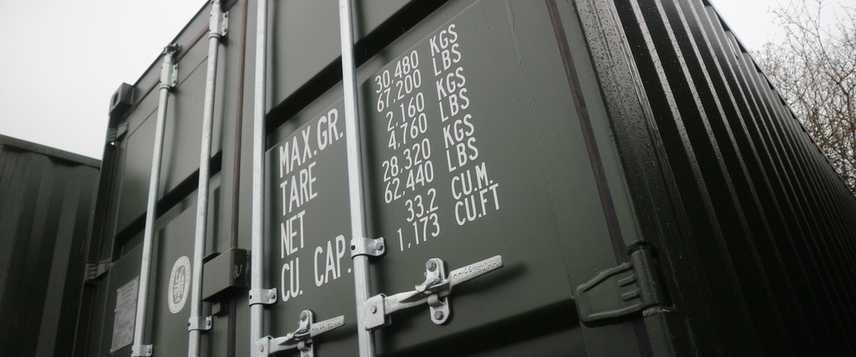Standard Shipping Container Dimensions
| Container Type | External Length | Internal Length | External Height | Internal Height | External Width | Internal Width |
|---|---|---|---|---|---|---|
| 20ft Shipping Container | 20ft (6.09m) | 19ft 9 inches (6.01m) | 8ft 6 inches (2.59m) | 7ft 10 inches (2.39m) | 8ft (2.44m) | 7ft 10 inches (2.34m) |
| 40ft Shipping Container | 40ft (12.18m) | 39ft 9 inches (12.11m) | 8ft 6 inches (2.59m) | 7ft 10 inches (2.39m) | 8ft (2.44m) | 7ft 10 inches (2.34m) |
| 20ft High Cube Shipping Container | 20ft (6.09m) | 19ft 9 inches (6.01m) | 9ft 6 inches (2.90m) | 8ft 10 inches (2.69m) | 8ft (2.44m) | 7ft 10 inches (2.3m) |
| 40ft High Cube Shipping Container | 40ft (12.18m) | 39ft 9 inches (12.11m) | 9ft 6 inches (2.90m) | 8ft 10 inches (2.69m) | 8ft (2.44m) | 7ft 10 inches (2.34m) |
External Shipping Container Dimensions
Container Lengths
20ft (6.09m) and 40ft (12.19m) are the industry standard container lengths.
For storage and other non-shipping applications other sizes are created by cutting down larger containers to the required size. The most common cut-down sizes are 8ft (2.44m), 12ft (3.66m), 16ft (4.88m), 24ft (7.32m) and 32ft (9.75m). Other bespoke sizes can also be manufactured to order.
For storage and other non-shipping applications other sizes are created by cutting down larger containers to the required size. The most common cut-down sizes are 8ft (2.44m), 12ft (3.66m), 16ft (4.88m), 24ft (7.32m) and 32ft (9.75m). Other bespoke sizes can also be manufactured to order.
Container Heights
A standard container is typically 8ft 6 inches (2.59m) high.
High Cube Containers are typically 9ft 6 inches (2.90m) high.
The most common height of a container is 8ft 6ins (2.59m), though 9ft 6 inches (2.90m) high-cube containers are becoming increasingly common. In the past 8ft high (2.44m) was very common and there are some containers 9ft (2.74m) available but these are rare.
High Cube Containers are typically 9ft 6 inches (2.90m) high.
The most common height of a container is 8ft 6ins (2.59m), though 9ft 6 inches (2.90m) high-cube containers are becoming increasingly common. In the past 8ft high (2.44m) was very common and there are some containers 9ft (2.74m) available but these are rare.
Container Widths
The standard width of a container is 8ft (2.44m). To accommodate some types of pallets, particularly in Europe 2.5m (8ft 2.4 inches) wide
containers are available though they are less commonly available to buy on the second-hand market.
Internal Shipping Container Dimensions
The sides of a container are in nearly all cases, corrugated. The depth of the corrugation is usually 1 inch (25mm),
which means that 2 inches (50mm) is lost from the external width dimension (1 inch each side). The back (blank end) is also
corrugated and the doors are around 2 inches (50mm) thick meaning that approximately 3 inches (75mm) is lost from the length.
The main reduction from external to internal dimensions is with height. The floor of a standard container has an underside clearance of approximately 6 inches (150mm) and the floor has a thickness of 27mm (1.1 inches). As the roof is corrugated another 1 inch (25mm) is lost resulting in an internal dimension of around 8 inches less than external – 7ft 10 inches (2.39m), though this can vary slightly either way depending on the floor thickness and construction method used.
Through the door height is additionally reduced because of the steel top rail above the door, this is a part of the structural integrity of the container, typically it's 4 inches (100mm) thus reducing the entrance height to 7ft 6ins (2.28m), though this can vary slightly either way.
The main reduction from external to internal dimensions is with height. The floor of a standard container has an underside clearance of approximately 6 inches (150mm) and the floor has a thickness of 27mm (1.1 inches). As the roof is corrugated another 1 inch (25mm) is lost resulting in an internal dimension of around 8 inches less than external – 7ft 10 inches (2.39m), though this can vary slightly either way depending on the floor thickness and construction method used.
Through the door height is additionally reduced because of the steel top rail above the door, this is a part of the structural integrity of the container, typically it's 4 inches (100mm) thus reducing the entrance height to 7ft 6ins (2.28m), though this can vary slightly either way.
Shipping Container Weights (Tare Weight, Gross Weight and Payload)
There are three relevant weights, the Tare Weight, the Gross Weight and the Payload.
These are painted onto the outside of the container doors when it is in shipping service or before
it has been repainted for another application.
- The Container Tare Weight is the weight of the container without cargo or contents.
- The Container Gross Weight is the weight of the container plus the maximum payload it can hold i.e. the maximum total weight of the container.
- The Payload (or Net Weight) is the weight of the cargo or contents that a container can hold.
| Length | 10 ft | 20 ft | 40 ft |
|---|---|---|---|
| Max Gross Weight | 11,300 kg | 30,480 kg | 30,400 kg |
| 24,910lbs | 67,200lbs | 67,200lbs | |
| Tare Weight | 1,300 kg | 2,160 kg | 3,750 kg |
| 2,870lbs | 4,760lbs | 8,270lbs | |
| Payload (or Net Weight) | 10,000 kg | 28,320 kg | 26,730 kg |
| 22,040lbs | 62,440lbs | 58,930lbs |
The most common alternative for 20fts is 24,000kg for stores manufactured to a lower specification.
Note that cut-down containers cannot hold the same weight when lifted as a standard container because the structure of the container has been altered. The container modification company should be able to supply details of capacities and advise if their design has been weight tested for lifting.
Note that cut-down containers cannot hold the same weight when lifted as a standard container because the structure of the container has been altered. The container modification company should be able to supply details of capacities and advise if their design has been weight tested for lifting.
Cubic Container Capacity
| Length | 10ft | 20ft | 40ft |
|---|---|---|---|
| Cubic Capacity | 15.95 cubic meters | 33.2 cubic meters | 67.59 cubic metres |
| 563.3 cubic feet | 1,173 cubic feet | 2,387 cubic feet |
Shipping Container Structure
Containers are designed to carry cargo. They are designed to be lifted vertically from above by
cranes and transferred from ship to shore and between other forms of transport such as trains and lorries.
Therefore they need to have strength in the top corners where they are engaged by the twistlocks of a container lifting crane.
The corner castings in the top corners of the container are therefore points of strength.
The strength is transferred down through the corner posts to the corner castings at the bottom and then through the floor. The floor is constructed of steel cross members approximately 6 inches (150mm) deep, which are approximately 20 inches (508mm) apart (laterally across the container) and give transverse strength and support the floor. The cross members are welded at each end to longitudinal beams which run the length of the container between the corner castings. This all means that the strength of a container lies within the corner posts and the floor. Structural alterations or damage to these components will weaken the container.
The information contained here is for guidance only. ContainerContainer do not accept any responsibility for any loss or damages resulting from use or interpretation of this information.
The strength is transferred down through the corner posts to the corner castings at the bottom and then through the floor. The floor is constructed of steel cross members approximately 6 inches (150mm) deep, which are approximately 20 inches (508mm) apart (laterally across the container) and give transverse strength and support the floor. The cross members are welded at each end to longitudinal beams which run the length of the container between the corner castings. This all means that the strength of a container lies within the corner posts and the floor. Structural alterations or damage to these components will weaken the container.
The information contained here is for guidance only. ContainerContainer do not accept any responsibility for any loss or damages resulting from use or interpretation of this information.


